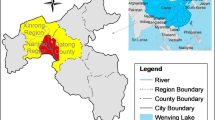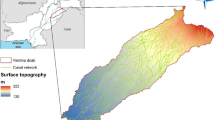Abstract
Most studies focused on producing contamination risk maps for aquifers usually calibrate a risk model utilizing some proxy or measure of contamination. The most common way of doing these risk maps is by calibrating some index-based model, such as DRASTIC. However, few studies focus and outline the differences between contamination risk maps that have been created for the same area but calibrated with different contaminants. Here, we present a modification of the well-known DRASTIC vulnerability model, in which anthropogenic parameters were added, and then calibrated with different contaminants (total nitrogen and total coliforms). The model incorporated anthropogenic parameters such as “land use”, “density of cesspools” and “major transport routes” as indicators of possible contamination sources. The pre- and post-calibration correlation coefficients for the total nitrogen risk maps were 0.073 and 0.522, respectively, while the pre- and post-calibration correlation coefficients for the total coliform maps were 0.357 and 0.7, respectively. After calibration and validation, the geostatistics of the maps were compared to understand how similar or different they were from each other. The comparison of the two maps showed that on average only 15% of the area are similar which implies that one risk map cannot suffice when describing the risk of contamination of a particular aquifer. This study is the first attempt of an in-depth analysis of the risk of contamination of the Patiño aquifer, where we show that 42% of the aquifer is at medium to high risk of contamination by either total nitrogen or total coliforms.










Similar content being viewed by others
References
Alam F, Umar R, Ahmad S, Dar AF (2014) A new model (DRASTIC-LU) for evaluating groundwater vulnerability in parts of central Ganga Plain, India. Arab J Geosci 7(3):927–937
Aller L (1985) DRASTIC: a standardized system for evaluating ground water pollution potential using hydrogeologic settings. In: Robert S. Kerr Environmental Research Laboratory (ed) US Environmental Protection Agency
Banco Interamericano de Desarrollo, B. I. D. (2014) Plan de Acción: Área Metropolitana de Asunción Sostenible. Iniciativa de Ciudades Emergentes y Sostenibles (ICES), Asunción
Cardozo LS, Crosa RC (2006) Estudio de la Contaminación del Acuífero Patiño, Trabajo Final de Grado. Universidad Nacional de Asunción, Paraguay
CKC-JNS (2007) Estudio de Políticas y Manejo Ambiental de Aguas Subterráneas en el Área Metropolitana de Asunción—Acuífero Patiño. In: S. E. N. A. S. A. Servicio Nacional de Saneamiento Ambiental (ed) Informe técnico 1.1: Resumen Ejecutivo, Asunción
Dirección General de Estadísticas Encuestas y Censos, D. G. E. E. C. (2012) Compendio Estadístico Ambiental del Paraguay—Año 2011, Asunción
Dirección General de Estadísticas Encuestas y Censos, D. G. E. E. C. (2015) General de Estadísticas Encuestas y Censos, D. G. E. E. C. Encuesta Permanente de Hogares, Asunción
Dixon B (2005) Groundwater vulnerability mapping: a GIS and fuzzy rule based integrated tool. Appl Geogr 25(4):327–347
Evans BM, Myers WL (1990) A GIS-based approach to evaluating regional groundwater pollution potential with DRASTIC. Soil Water Conserv 45(2):242–245
Field CB, Barros VR, Mastrandrea MD (2014) Summary for policymakers. Climate change 2014: impacts, adaptation, and vulnerability. Part A: global and sectoral aspects. Contribution of working group II to the fifth assessment report of the intergovernmental panel on climate change, pp 1–32
Forestry and Forest Products Research Institute, F. F. P. R. I., and Facultad de Ciencias Agrarias UNA, F. C. A. (2011) Cobertura de la Tierra Paraguay, San Lorenzo
Foster SSD (1987) Fundamental concepts in aquifer vulnerability, pollution risk and protection strategy. In: Paper presented at the international conference, 1987. Noordwijk Aan Zee, The Netherlands Vulnerability of Soil and Groundwater to Pollutants. Netherlands Organization for Applied Scientific Research, The Hague
Foster S, Hirata R, Gomes D, D’Elia M, Paris M (2003) Protección de la calidad del agua subterránea. Banco Mundial
Harris IPDJ, Jones PD, Osborn TJ, Lister DH (2014) Updated high-resolution grids of monthly climatic observations—the CRU TS3. 10 Dataset. Int J Climatol 34(3):623–642
Hiriart M (2005) Impactos Ambientales: Acuíferos. http://www.ine.gob.mx/ueajei/publicaciones/libros/35/impactos.html. Accessed 04 Dec 2013
Instituto Holandés de Geociencias Aplicadas, T. N. O. (2001) Estudio del Acuífero Patiño. Fortalecimiento de los Estudios Hidrogeológicos del SENASA (FEHS). In: S. E. N. A. S. A. Servicio Nacional de Saneamiento Ambiental (ed) Asunción
Jarvis A, Reuter HI, Nelson A, Guevara E (2013) Hole-filled SRTM for the Globe Version 4.1 CGIAR-CSI SRTM 90 m Database 2008. http://srtm.csi.cgiar.org. Accessed 13 March 2013
Kalinski RJ, Kelly WE, Bogardi I, Ehrman RL, Yaniamoto PD (1994) Correlation between DRASTIC vulnerabilities and incidents of VOC contamination of municipal wells in Nebraska. Groundwater 32(1):31–34
Lambrakis N, Antonakos A, Panagopoulos GP (2004) The use of multicomponent statistical analysis in hydrogeological environmental research. Water Res 38(7):1862–1872
Lindström R (2005) Groundwater vulnerability assessment using process-based models. Doctoral dissertation. KTH Royal Institute of Technology, Stockholm
López O, González E, de Llamas PA, Molinas AS, Franco ES, García S et al (1995) Proyecto de Racionalizacion del Uso de la Tierra. In: M. A. G. Ministerio de Agricultura y Ganadería, S. E. R. N. M. A. Subsecretaria de Estado de Recursos Naturales y Medio Ambiente, Banco BM, Mundial (eds) Estudio de Reconocimiento de Suelos, Capacidad de Uso de la Tierra y Propuesta de Ordenamiento Territorial Preliminar de la Región Oriental del Paraguay, vol I, Asunción
Mazari-Hiriart M, Cruz-Bello G, Bojórquez-Tapia LA, Juárez-Marusich L, Alcantar-López G, Marín LE et al (2006) Groundwater vulnerability assessment for organic compounds: fuzzy multicriteria approach for Mexico City. Environ Manag 37(3):410–421
McLay CDA, Dragden R, Sparling G, Selvarajah N (2001) Predicting groundwater nitrate concentrations in a region of mixed agricultural land use: a comparison of three approaches. Environ Pollut 115(2):191–204
Mishima Y, Takada M, Kitagawa R (2011) Evaluation of intrinsic vulnerability to nitrate contamination of groundwater: appropriate fertilizer application management. Environ Earth Sci 63(3):571–580
Monte R, Báez J (2007) Informe técnico 2.11: Balance Hídrico del Acuífero Patiño. In: CKC-JNS, S.E.N.A.S.A. (eds) Estudio de Políticas y Manejo Ambiental de Aguas Subterráneas en el Área Metropolitana de Asunción—Acuífero Patiño, Asunción
National Research Council, N. R. C (1993) Ground water vulnerability assessment: contamination potential under conditions of uncertainty. Committee on Techniques for Assessing Ground Water Vulnerability. Water science and technology board, commission on geosciences, environment, and resources, vol 179. National Academy Press, Washington DC
Nobre RCM, Rotunno OC, Mansur WJ, Nobre MMM, Cosenza CAN (2007) Groundwater vulnerability and risk mapping using GIS, modeling and a fuzzy logic tool. J Contam Hyrol 94(3–4):277–292
Pacheco FA, Fernandes LFS (2013) The multivariate statistical structure of DRASTIC model. J Hydrol 476:442–459
Panagopoulos GP, Antonakos AK, Lambrakis NJ (2006) Optimization of the DRASTIC method for groundwater vulnerability assessment via the use of simple statistical methods and GIS. Hydrogeol J 14(6):894–911
Rupert MG (1999) Improvements to the DRASTIC ground-water vulnerability mapping method. US Geological Survey (No. 066-99)
Sadat-Noori M, Ebrahimi K (2016) Groundwater vulnerability assessment in agricultural areas using a modified DRASTIC model. Environ Monit Assess 188(1):19
Saha D, Alam F (2014) Groundwater vulnerability assessment using DRASTIC and Pesticide DRASTIC models in intense agriculture area of the Gangetic plains, India. Environ Monit Assess 186(12):8741–8763
Secunda S, Collin ML, Melloul AJ (1998) Groundwater vulnerability assessment using a composite model combining DRASTIC with extensive agricultural land use in Israel’s Sharon region. J Environ Manag 54(1):39–57
Singh A, Srivastav SK, Kumar S, Chakrapani GJ (2015) A modified-DRASTIC model (DRASTICA) for assessment of groundwater vulnerability to pollution in an urbanized environment in Lucknow, India. Environ Earth Sci 74(7):5475–5490
Vaezihir A, Tabarmayeh M (2015) Total vulnerability estimation for the Tabriz aquifer (Iran) by combining a new model with DRASTIC. Environ Earth Sci 74(4):2949–2965
Wehrle A (2007) Informe técnico 2.9: Inventario de Fuentes Potenciales de Contaminación. In: CKC-JNS (ed) Estudio de Políticas y Manejo Ambiental de Aguas Subterráneas en el Área Metropolitana de Asunción—Acuífero Patiño, Asunción
Wehrle A, Lopez D (2007) Informe técnico 2.6: Perforación de Pozos Piezométricos. In: CKC-JNS (ed) Estudio de Políticas y Manejo Ambiental de Aguas Subterráneas en el Área Metropolitana de Asunción—Acuífero Patiño, Asunción
Wehrle A, Sekita K (2007) Informe técnico 2.8: Ensayos de Bombeo. In: CKC-JNS (eds) Estudio de Políticas y Manejo Ambiental de Aguas Subterráneas en el Área Metropolitana de Asunción—Acuífero Patiño, Asunción
Wu H, Chen J, Qian H (2016) A modified DRASTIC model for assessing contamination risk of groundwater in the northern suburb of Yinchuan, China. Environ Earth Sci 75(6):483
Acknowledgements
This study was founded by the Consejo Nacional de Ciencia y Tecnología (CONACyT) through PROCIENCIA, in the project framework INV-190 Monitoring and simulation of transport of contaminations in urban areas of the Patiño aquifer. Program resources Fondo para la Excelencia de la Educación e Investigación—FEEI of FONACIDE, and by the Facultad Politécnica—Universidad Nacional de Asunción. In addition, it was supported by the Secretaría de Emergencia Nacional. The authors would also like to acknowledge the anonymous reviewers who gave significant inputs and comments on how to make the paper better.
Author information
Authors and Affiliations
Corresponding author
Additional information
Publisher’s Note
Springer Nature remains neutral with regard to jurisdictional claims in published maps and institutional affiliations.
Rights and permissions
About this article
Cite this article
Baez, L., Villalba, C. & Nogues, J.P. Comparison of contaminant-specific risk maps for an urban aquifer: Patiño aquifer case. Environ Earth Sci 78, 137 (2019). https://doi.org/10.1007/s12665-019-8141-3
Received:
Accepted:
Published:
DOI: https://doi.org/10.1007/s12665-019-8141-3




